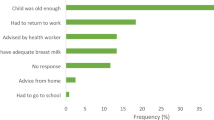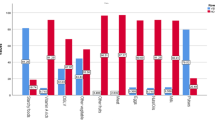Abstract
Background/Objective:
To assess the traditional postpartum practices, mother and child nutritional status and associated factors.
Subjects/Methods:
A cross-sectional study in 41 randomly selected villages on the outskirts of Vientiane capital city, Lao PDR (Laos). 300 pairs of infants (<6 months of age) and their mothers were enrolled. Information was collected about pregnancy, delivery and traditional practices through a standardized questionnaire. Dietary intake and food frequency were estimated using the 24 h recall method, calibrated bowls and FAO food composition tables. Mothers' and infants' anthropometry was assessed and multivariate analysis performed.
Results:
Contrasting with a high antenatal care attendance (91%) and delivery under health professional supervision (72%), a high prevalence of traditional practices was found, including exposure to hot beds of embers (97%), use of traditional herb tea as the only beverage (95%) and restricted diets (90%). Twenty-five mothers (8.3%) were underweight. Mothers had insufficient intake of calories (55.6%), lipids (67.4%), iron (92.0%), vitamins A (99.3%) and C (45%), thiamin (96.6%) and calcium (96.6%). Chewed glutinous rice was given to infants as an early (mean 34.6, 95% CI:29.3–39.8 days) complementary food by 53.7% of mothers, and was associated with stunting in 10% children (OR=1.35, 95% CI:1.04–1.75).
Conclusion:
The high prevalence of traditional postpartum restricted diets and practices, and inadequate maternal nutritional intake in urban Laos, suggest that antenatal care may be an important opportunity to improve postpartum diets.
This is a preview of subscription content, access via your institution
Access options
Subscribe to this journal
Receive 12 print issues and online access
$259.00 per year
only $21.58 per issue
Buy this article
- Purchase on Springer Link
- Instant access to full article PDF
Prices may be subject to local taxes which are calculated during checkout

Similar content being viewed by others
References
Drewett R, Amatayakul K, Wongsawasdii L, Mangklabruks A, Ruckpaopunt S, Ruangyuttikarn C et al. (1993). Nursing frequency and the energy intake from breast milk and supplementary food in a rural Thai population: a longitudinal study. Eur J Clin Nutr 47, 880–891.
FAO (1972). Food Composition Table for Use in East Asia. FAO Food Policy and Nutrition Division and US Department of health education and welfare: Rome. Part II Section A 1–334. available at: http://www.FAO.org/docrep/003/X6878E/X6878E00.htm#TOC.
FAO/WHO (1998). Carbohydrates in human nutrition. (FAO Food and Nutrition Paper–66). Report of a Joint FAO/WHO Expert Consultation available at: http://www.fao.org/docrep/W8079E/W8079E00.htm.
FAO and IUCN (2003). The Role and Nutritional Value of Aquatic Resources in the Livelihoods of Rural People A Participatory Assessment in Attapeu Province, Lao PDR. available at: www.FAO.org/docrep/004/ad454e/ad454e00.htm.
Gerhold C (1967). Food habits of the valley people of Laos. J Am Diet Assoc 50, 493–497.
Giugliani ERJ, Victora CS (2000). Complementary feeding. J Pediatr 76 (Suppl 3), 253–262.
Graz B (1999). Impact on health of early supplementation with rice in infants in Laos. Med Trop 59, 102–103.
Kachondham Y, Dhanamitta S (1992). A new horizon: addressing food and nutrition problems in the Lao People's Democratic Republic. Food Nutr Bull 14, 79–87.
Kaewsarn P, Moyle W, Creedy D (2003). Thai nurses' beliefs about breastfeeding and postpartum practices. J Clin Nurs 12, 467–475.
Kaufmann S, Marchesich R, Dop MC (2003). FAO Nutrition Country Laos. FAO Nutrition Country Profiles: Rome. pp 1–38. available at: http://www.fao.org/ad/agn/nutrition/lao-e.stm.
Kaufmann S, Phanlavong A, Kohl G (2001). Nutrition and Poverty in Northern Laos: Achievements after 4 Years of Intensive Interventions. Institute of Nutritional Sciences, University of Giessen: Germany (Lao-German Integrated Food Security Program). available at: http://www.uni-giessen.de/fbr09/int-nutr/Forschung-Arbeitskreis/POSTER-Silvia-Kaufmann.pdf.
Khamhong K, Bodhisane N, Pathammavong C, Ouenvilay S, Senthavisouk B, Pongpaew P et al. (2000). Nutritional status of pre-school children and women in selected villages in the Suvannakhet Province, Lao PDR-an intervention trial. Southeast Asian J Trop Med Public Health 31 (Suppl 2), 63–74.
King H, Keuky L, Seng S, Khun T, Roglic G, Pinget M (2005). Diabetes and associated disorders in Cambodia: two epidemiological surveys. Lancet 366, 1633–1639.
Latham MC (1997). Human Nutrition in the Developing World (FAO Food Nutrition Series No. 29) ISBN 92-5-103818-X: available at: http://www.FAO.org/docrep/W0073E/W0073E00.htm.
Marr JV (1971). Individual dietary surveys: purposes and methods. World Rev Nutr Diet 13, 105–164.
Ministry of Health, Lao PDR (2001). Health Status of the People in Lao PDR. National Institute of Public Health, Ministry of Health: Vientiane. pp 1–144.
Miyoshi M, Phommasack B, Nakamura S, Kuroiwa C (2005). Nutritional status of children in rural Lao PDR: who are the most vulnerable? Eur J Clin Nutr 59, 887–890.
Perks C, Toole MJ, Phouthonsy K (2006). District health programmes and health-sector reform: case study in the Lao People's Democratic Republic. Bull World Health Organ 84, 132–138.
Phengxay M, Ali M, Yagyu F, Phengxay S, Kuroiwa C, Ushijima H (2007). Risk factors for protein—energy malnutrition in children under 5 years: study from Luangprabang province, Laos. Ped Int 49, 260–265.
Pottier R (1978). Santé et Société au Laos (1973–78) pp 1-504. Paris Comité de Coopération avec le Laos (Ed). ISBN: 2914898568.
Santos-Torres MI, Vasquez-Garibay E (2003). Food taboos among nursing mothers of Mexico. J Health Popul Nutr 21, 142–149.
Saowakontha S, Chantraphosri V, Kampor P, Ketkowit K, Panomratanarak B, Thaworndunstid P et al. (1995). Breast feeding behavior and supplementary food pattern of villagers in Udon Thani Province, northeast Thailand. Southeast Asian J Trop Med Public Health 26, 73–77.
Sayasone S, Odermatt P, Khammanivong K, Phomluangsyl S, Vinhl CV, Thin HM et al. (2004). Bladder stones in childhood: a descriptive study in a rural setting in Saravan Province, Lao PDR. Southeast Asian J Trop Med Public Health 35 (Suppl 2), S50–S52.
Soukaloun D, Kounnavong S, Pengdy B, Boupha B, Durondej S, Olness K et al. (2003). Dietary and socio-economic factors associated with beriberi in breastfed Lao infants. Ann Trop Paediatr 23, 181–186.
Trigo M, Roncada MJ, Stewien GT, Pereira IM (1989). Food taboos in the northern region of Brazil. Rev Saude Publica 23, 455–464.
UNICEF (2006). Situation des Enfants dans le Monde 2006 New York. Available at: http://www.unicef.org/french/sowc.06/statistics/tables.php.
United Nations (1986). How to Weigh and Measure Children: Assessing the Nutritional Status of Young Children in Household Surveys. Department of Technical Co-operation for Development and Statistical Annexe 1: New York. United Nations, ISBN-13: 978-92-806-3917-9.
United Nations Development Program (2006). Human Development Report 2004: Cultural Liberty in Today's Diverse World. UNDP: New York. available at: http://hdr.undp.org/en/reports/global/hdr2004/.
Valyasevi ASB, Halstead S, Pantuwatana C, Tankayul C (1967). Studies of bladder stone disease in Thailand. IV. Dietary habits, nutritional intake, and infant feeding practices among residents of a hypo- and hyper-endemic areas. Am J Clin Nutr 20, 1340–1351.
Vimokesant SL, Hilker DM, Nakornchai S, Rungruangsak K, Dhanamitta S (1975). Effects of betel nut and fermented fish on the thiamin status of northeastern Thais. Am J Clin Nutr 28, 1458–1463.
WHO (1998). Complementary Feeding of Young Children in Developing Countries: A Review of Current Scientific Knowledge available from http://www.who.int/child-adolescenthealth/publications/NUTRITION/WHO_NUT_98.1.htm.
WHO Expert Consultation (2004). Appropriate body-mass index for Asian populations and its implications for policy and intervention strategies. Lancet 363, 157–163.
Acknowledgements
We are grateful for the assistance and collaboration of the health authorities of Vientiane Municipality and for the participation and interest of the mothers with their children. The assistance of V Phuangsavady, P Brossman, Mayfong Mayxay, JP René, L Srour and the staff of Institut de la Francophonie pour la Médecine Tropicale is gratefully acknowledged. Financial support was granted by Agence Universitaire de la Francophonie. Paul N Newton is supported by the Wellcome Trust (UK).
Author information
Authors and Affiliations
Corresponding author
Rights and permissions
About this article
Cite this article
Barennes, H., Simmala, C., Odermatt, P. et al. Postpartum traditions and nutrition practices among urban Lao women and their infants in Vientiane, Lao PDR. Eur J Clin Nutr 63, 323–331 (2009). https://doi.org/10.1038/sj.ejcn.1602928
Received:
Revised:
Accepted:
Published:
Issue Date:
DOI: https://doi.org/10.1038/sj.ejcn.1602928
Keywords
This article is cited by
-
Enhancing child dietary diversity through cooking demonstration and nutritional education in rural Lao PDR
Tropical Medicine and Health (2024)
-
Divergence in Nutritional Intake and Physical Activity Patterns Among Households in a Village of Ethnic Minorities in Northern Laos at the Initial Stage of Health Transition
Human Ecology (2022)
-
Are dietary intake and nutritional status influenced by gender? The pattern of dietary intake in Lao PDR: a developing country
Nutrition Journal (2020)
-
Trends and risk factors for infant mortality in the Lao People’s Democratic Republic
Scientific Reports (2020)
-
Feeding practices and risk factors for chronic infant undernutrition among refugees and migrants along the Thailand-Myanmar border: a mixed-methods study
BMC Public Health (2019)



